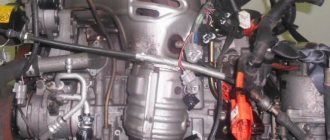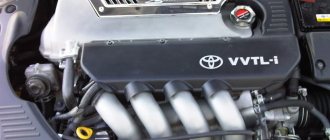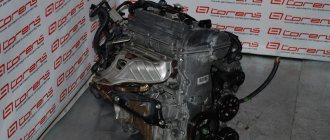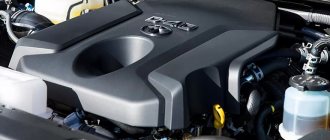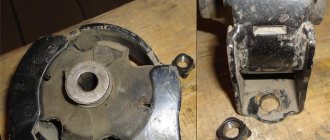For a long period of time, it was Toyota brand power units that were considered the best and most reliable. According to most car enthusiasts, engines practically do not break down under intensive use. One can argue with this statement, since repair statistics indicate the opposite. In terms of reliability, individual engine models do not stand out at all from their analogues in terms of characteristics and cost. For example, the Toyota 3.0 D-4D diesel turbo engine does not have the best design and can fail at the most inopportune moment.
A 3-liter power unit labeled 1KD-FTV first appeared on the market almost 20 years ago, in 2000. The manufacturer was one of the first to install a Common Rail fuel system on a large-volume turbocharged engine. The Delphi company developed the injection module for the concern.
Similar power units were installed on full-size Toyota SUVs. The Land Cruiser Prado 120 was the first to receive the 1KD-FTV engine; after a while, engines began to be installed on the Prado 150. The manufacturer did not limit itself to two models.
At various times, 3.0 D-4D power units were mounted on pickups and other Toyota models, for example, Hilux, 4Runner, HiAce. Cars with such engines were exported to many countries on all world continents. As technology developed, 1KD-FTV engines gave way to GD power units, whose displacement was 2.4 or 2.8 liters.
Structurally, the cylinder block of the power unit of this modification consists entirely of cast iron. A distinctive feature of the motor is the absence of sleeves. All aluminum elements are used as pistons. The piston skirts are coated with rubber. The 1KD-FTV motor includes 2 balancer shafts. The crankshaft with counterweights is responsible for the movement of the balancers; the moment is transmitted using a gear drive.
Aluminum alloy was also used to produce the cylinder head. The cylinder head includes two camshafts, each cylinder has 4 valves. One of the features of the engine is the absence of hydraulic compensators. Thermal clearances are adjusted using disc-type pushers.
Another feature of the engine is the presence of a timing drive of a non-standard design. The assembly includes a gear transmission, two balancer shafts, an injection pump and an oil pump. The timing belt drives the intake and exhaust shafts using reliable and durable mechanisms. In this case, the belt must be replaced at least every 100 thousand kilometers. To monitor the mileage, a special counter is installed, which informs the driver about the need for maintenance.
Toyota cars with this engine are equipped with a CT16V turbocharger. The technical characteristics of the module allow air to be pumped up to a value of 1.1 bar. To cool the incoming air flow, an intercooler is used, which is installed under the plastic engine cover. 1KD-FTV power units are made in accordance with Euro-3 and higher standards. The engine includes an exhaust gas recirculation system labeled EGR.
About engines for Toyota Land Cruiser Prado
The frame SUV Toyota Land Cruiser Prado has become a kind of smaller version of the bulky Land Cruiser. Based on this model, the Lexus GX is produced, which is not particularly different from the Toyota SUV. The engines on the Land Cruiser Prado are mainly of large volume 2.7-4.0 liters.
Engine Toyota 3RZ-FE
The 2.7-liter 3RZ power unit became a follower of the old R series and was intended for large cars. This volume for a 4-cylinder engine was achieved thanks to their diameter of 95 mm and a forged crankshaft with 8 counterweights and a piston stroke of 95 mm.
Two balancer shafts were placed in the crankcase, which balance the inertial forces. The aluminum cylinder head received two DOHC camshafts and four valves per cylinder.
There are no hydraulic compensators, and valve clearances need to be adjusted every 30-40 thousand kilometers. The intake camshaft is driven by a timing chain drive, which can last for about 200 thousand km. The engine uses an ESA electronic ignition timing control system.
The engine turned out to be extremely successful and no obvious flaws were identified. All that is required is to use high-quality consumables and regular maintenance. 5-
Engine Toyota 2TR-FE
The 3RZ engine, which was outdated in 2003, was followed by its successor 2TR, which took a cylinder block with a pair of balancer shafts from the previous successful model and improved the cylinder head. The head used a variable phase system on the VVTi intake camshaft and hydraulic compensators appeared.
The timing chain, plastic intake manifold and electronic throttle body have also been upgraded. The control unit was installed completely different.
All these improvements added 10 horsepower to the Toyota 2TR-FE engine, reduced fuel consumption and improved traction.
Since 2015, the IFGR system on two Dual-VVTi shafts has been used on the motor.
In terms of reliability, the new engine is not inferior to its predecessor, that is, no obvious deficiencies were identified except for a leak in the front crankshaft oil seal. But this drawback was eliminated after 2008. 5-
Engine Toyota 5VZ-FE
In 1995, based on the 3VZ-E engine, another engine for Toyota SUVs was developed. The 5VZ unit received a V6 BC with a 60-degree camber, but unlike its predecessor, the cylinders were increased to 93.5 mm with new pistons for a compression ratio of 9.6, which made it possible to increase the engine volume to 3.4 liters.
The 5VZ is equipped with modern cylinder heads with a pair of low-level camshafts. The designers modified the cooling system fan and used an oil cooler.
In addition, the exhaust manifold and ignition system were optimized and phased fuel injection was used.
Overall the engine is reliable and the cylinder head gasket problem has been resolved. But the engine overheated due to an imperfect cooling system fan, radiator cap, thermostat or condition of the radiator. Premature wear of the connecting rod bearings was also noted. 4
Engine Toyota 1GR-FE 4.0 l
In 2002, the 5VZ engine displaced the new 4.0-liter 1GR V6 unit with a camber angle of 60 degrees from the market.
The not-so-revving engine is compensated by good torque.
As with all modern Toyota units, the 1GR-FE received an aluminum BC with cast iron liners. In 2009, a heavy ShPG, crankshaft and VVTi on intake shafts with a capacity of 249 hp. replaced by improved versions with Dual-VVTi, an improved cylinder head, using lightweight pistons, a modified intake and increased power to 285 “horses”.
The first versions of Toyota 1GR-FE had problems with overheating and cylinder head gasket breakdowns occurred, which forced us to monitor the cooling system.
There are no hydraulic compensators, which forces the valve clearances to be adjusted every 100 km. 4
| Engines | Toyota 3RZ-FE | Toyota 2TR-FE | Toyota 5VZ-FE | Toyota 1GR-FE |
| Production | Kamigo Plant | Kamigo Plant Toyota Motor Manufacturing Indonesia | Toyota Motor Manufacturing Alabama | Kamigo Plant Shimoyama Plant Tahara Plant Toyota Motor Manufacturing Alabama |
| Engine make | 3RZ | 2TR | 5VZ | Toyota 1GR |
| Years of manufacture | 1994-2004 | 2003-present | 1995-2004 | 2002-present day |
| Cylinder block material | cast iron | cast iron | cast iron | aluminum |
| Supply system | injector | injector | injector | injector |
| Type | in-line | in-line | V-shaped | V-shaped |
| Number of cylinders | 4 | 4 | 6 | 6 |
| Valves per cylinder | 4 | 4 | 4 | 4 |
| Piston stroke, mm | 95 | 95 | 82 | 95 |
| Cylinder diameter, mm | 95 | 95 | 93,5 | 94 |
| Compression ratio | 9.5 | 9,6 10.2 (Dual-VVTi) | 9,6 | 10 10.4 |
| Engine capacity, cc | 2693 | 2693 | 3378 | 3956 |
| Engine power, hp/rpm | 150/4800 | 160/5200 163/5500 | 190/4800 | 236/5200 239/5200 270/5600 285/5600 |
| Torque, Nm/rpm | 240/4000 | 241/3800 246/3800 | 298/3600 | 361/4000 377/3700 377/4400 387/4400 |
| Fuel | 95 | 95 | 95 | 95 |
| Environmental standards | — | Euro 4 | — | Euro 5 |
| Engine weight, kg | 173 | — | 190 | 166 |
| Fuel consumption, l/100 km (for Prado 120) - city - highway - mixed. | 16.0 9.5 12.0 | 11.2 9.4 10.7 | 20.0 11.0 14.0 | 14.7 11.8 13.8 |
| Oil consumption, g/1000 km | up to 1000 | up to 1000 | up to 1000 | up to 1000 |
| Engine oil | 0W-30 5W-30 5W-40 10W-30 10W-40 1oW-50 15W-50 | 0W-20 5W-20 | 0W-30 5W-30 5W-40 10W-30 | 5W-30 |
| How much oil is in the engine, l | 5.1 | 5.8 | 5.3 | 5.2 |
| Oil change carried out, km | 7000-10000 | 7000-10000 | 7000-10000 | 10000 (better 5000) |
| Engine operating temperature, degrees. | 85-90 | 85-90 | ~90 | — |
| Engine life, thousand km - according to the plant - in practice | — 400+ | — 400+ | — 300+ | n.d. 300+ |
| Tuning, hp — potential — without loss of resource | 300+ n.a. | 300+ n.a. | 400+ n.a. | 350-400 n.d. |
| The engine was installed | Toyota 4Runner Toyota HiAce Regius Toyota Hilux Toyota Land Cruiser Prado Toyota T100 Toyota Tacoma | Toyota 4Runner Toyota HiAce Toyota Hilux Toyota Land Cruiser Prado Toyota Tacoma Toyota Fortuner Toyota Innova | Toyota 4Runner Toyota Land Cruiser Prado Toyota Tacoma Toyota Tundra Toyota T-100 Toyota Granvia GAZ 3111 Volga | Toyota 4Runner Toyota FJ Cruiser Toyota Hilux Toyota Land Cruiser 200 Toyota Land Cruiser Prado 120 Toyota Land Cruiser Prado 150 Toyota Tacoma Toyota Tundra Lexus GX 400 (China) |
What problems may Toyota owners with a 1KD-FTV engine encounter?
The reliability of Toyota power units has always been considered one of the advantages of the brand. At the same time, almost every model has typical disadvantages. For engines with the 1KD-FTV index, manufactured in accordance with the Euro-4 standard, the problem may appear in the form of cracking of the pistons.
For Toyota 3.0 D-4D power units produced from 2000 to 2003 (marking 30020-30060), this problem is not relevant. During intensive use, the pistons completely exhaust their service life. After the modernization at the end of 2003, cases of cracking of the pistons began to occur. The risk group included 1KD-FTV engines with a power of up to 172 horsepower and a torque of 410 Nm.
Since 2004, modified pistons with a modified combustion chamber shape have been installed on power units of this brand. For motors with index 30090 manufactured before August 2006, the problem of cracking is not common. 30150 power units manufactured before June 2009 are most susceptible to this problem.
The automaker, after identifying the defect, took measures to modify the 1KD-FTV engines. At the end of 2010, Toyota Euro-5 standard cars began to be equipped with engines with a modified piston group. Owners of equipment with power units 13101-30170 did not report a similar problem to the manufacturer. At the same time, on problem engines, the pistons were replaced with parts with index 0.
Cracks in the pistons of the Toyota 3.0 D-4D (1KD-FTV) engine
The unsuccessful design of the piston group is explained by the excessive fragility of the alloy. A crack in the working element most often appeared during long-term operation, especially at high speed and in the summer heat. If the owner tried to tune the power unit, the service life of the pistons of problematic engines was also significantly reduced. Toyota did not deny the problem and took all necessary measures to eliminate it.
Signs of cracking of the piston group were difficult to confuse with other failures. At a mileage of 100 to 150 thousand kilometers, a metallic knock appeared, accompanied by thick black smoke from the exhaust pipe. Engine power dropped significantly, and excessive formation of crankcase gases occurred. For diagnostics it was necessary to open the power unit.
The simplest solution to this problem is to replace the cracked piston with a modernized model. If pieces of metal break off from the working unit, you will have to repair or completely replace the unit. Diesel Land Cruiser Prado 120 were in great demand in the UK and Australia, so the percentage of calls to service centers due to cracking pistons in these countries is traditionally high.
Technical characteristics and volume
Toyota Land Cruiser Prado is an SUV built using a frame structure. It is a kind of smaller version of the large Toyota Land Cruiser. In the line of Toyota SUVs and SUVs, it stands between the Land Cruiser/Sequoia and Highlander/FJ Cruiser, and is also on the same level as the 4Runner.
TOYOTA LAND CRUISER PRADO.
Competitors include Mitsubishi Pajero, Nissan Pathfinder, Honda Pilot, Volkswagen Touareg, Range Rover Sport and the like. Based on the Toyota Prado, a sister brand, the Lexus GX is produced and has no serious external differences from the Toyota SUV.
Let's look at several technical characteristics of Toyota LAND CRUISER PRADO power units:
2nd generation, 90 (1996 - 2002):
- Toyota Land Cruiser Prado 90 (150 hp) - 2.7 l.
- Toyota Land Cruiser Prado 90 (185 hp) - 3.4 l.
- Toyota Land Cruiser Prado 90 (90 hp) - 2.8 l. D
- Toyota Land Cruiser Prado 90 (106 hp) - 3.0 l. D
- Toyota Land Cruiser Prado 90 (125 hp) - 3.0 l. T.D.
- Toyota Land Cruiser Prado 90 (130 hp) - 3.0 l. T.D.
- Toyota Land Cruiser Prado 90 (140 hp) - 3.0 l. T.D.
- Toyota Land Cruiser Prado 90 (145 hp) - 3.0 l. T.D.
- Toyota Land Cruiser Prado 90 (170 hp) - 3.0 l. T.D.
3rd generation, 120 (2002 - 2009):
- Toyota Land Cruiser Prado 120 (150 hp) - 2.7 l.
- Toyota Land Cruiser Prado 120 (163 hp) - 2.7 l.
- Toyota Land Cruiser Prado 120 (185 hp) - 3.4 l.
- Toyota Land Cruiser Prado 120 (249 hp) - 4.0 l.
- Toyota Land Cruiser Prado 120 (95 hp) - 3.0 l. D
- Toyota Land Cruiser Prado 120 (170 hp) - 3.0 l. T.D.
4th generation, 150 (2009 - present):
- Toyota Land Cruiser Prado 150 (163 hp) - 2.7 l.
- Toyota Land Cruiser Prado 150 (282 hp) - 4.0 l.
- Toyota Land Cruiser Prado 150 (177 hp) - 2.8 l. D
- Toyota Land Cruiser Prado 150 (95 hp) - 3.0 l. D
- Toyota Land Cruiser Prado 150 (173 hp) - 3.0 l. T.D.
- Toyota Land Cruiser Prado 150 (190 hp) - 3.0 l. T.D.
Engine TOYOTA LAND CRUISER PRADO.
Second generation
Let's look at the main technical characteristics of 3RZ:
| Name | Characteristics |
| Manufacturer | Kamigo Plant |
| Motor brand | 3RZ |
| Volume | 2.7 liters (2693 cm3) |
| Power | 150 hp |
| Cylinder diameter | 95 mm |
| Number of cylinders | 4 |
| Number of valves | 16 |
| Fuel consumption | 12.0 liters for every 100 km in mixed mode |
| Engine oil | 0W-30 5W-30 5W-40 10W-30 10W-40 1oW-50 15W-50 |
| Resource | 200+ thousand km |
| Applicability | Toyota 4Runner Toyota HiAce Regius Toyota Hilux Toyota Land Cruiser Prado Toyota T100 Toyota Tacoma |
Let's look at the main technical characteristics of 5VZ:
| Name | Characteristics |
| Manufacturer | Toyota Motor Manufacturing Alabama |
| Motor brand | 5VZ |
| Volume | 3.4 liters (3378 cm3) |
| Power | 190 hp |
| Cylinder diameter | 93.5 mm |
| Number of cylinders | 6 |
| Number of valves | 24 |
| Fuel consumption | 14.0 liters for every 100 km in mixed mode |
| Engine oil | 0W-30 5W-30 5W-40 10W-30 |
| Resource | 300+ thousand km |
| Applicability | Toyota 4Runner Toyota Land Cruiser Prado Toyota Tacoma Toyota Tundra Toyota T-100 Toyota Granvia GAZ 3111 Volga |
Let's look at the main technical characteristics of 1KZ:
| Name | Characteristics |
| Manufacturer | Toyota Motor Corporation |
| Motor brand | 1KZ |
| Volume | 3.0 liters (2982 cm3) |
| Power | 125/3600 130/3600 145/3600 |
| Cylinder diameter | 96 mm |
| Number of cylinders | 4 |
| Number of valves | 8 |
| Fuel consumption | 11.0 liters for every 100 km in mixed mode |
| Engine oil | 5W-30 5W-40 10W-30 10W-40 15W-40 |
| Resource | 500+ thousand km |
| Applicability | Toyota 4Runner/Hilux Surf Toyota HiAce Toyota Hilux Toyota Land Cruiser Prado 70/90 |
Third generation
This generation uses second-generation engines, as well as new power units.
Let's look at the main technical characteristics of 2TR-FE:
| Name | Characteristics |
| Manufacturer | Kamigo Plant Toyota Motor Manufacturing Indonesia |
| Motor brand | 2TR-FE |
| Volume | 2.7 liters (2693 cm3) |
| Power | 160-163 hp |
| Cylinder diameter | 95 mm |
| Number of cylinders | 4 |
| Number of valves | 16 |
| Fuel consumption | 10.5 liters for every 100 km in mixed mode |
| Engine oil | 5W-20 0W-20 |
| Resource | 400+ thousand km |
| Applicability | Toyota 4Runner Toyota HiAce Toyota Hilux Toyota Land Cruiser Prado Toyota Tacoma Toyota Fortuner Toyota Innova |
Let's look at the main technical characteristics of 1KD:
| Name | Characteristics |
| Manufacturer | Toyota Motor Manufacturing Alabama |
| Motor brand | 1KD |
| Volume | 3.0 liters (2982 cm3) |
| Power | 109/3000 136/3400 163/3400 170/3600 173/3400 |
| Cylinder diameter | 96 mm |
| Number of cylinders | 4 |
| Number of valves | 16 |
| Fuel consumption | 8.1 liters for every 100 km driven in mixed mode |
| Engine oil | 0W-30 (from 10.2010) 5W-30 10W-30 15W-40 20W-50 |
| Resource | 400+ thousand km |
| Applicability | Toyota 4Runner/Hilux Surf Toyota HiAce Toyota Hilux Toyota Land Cruiser Prado 120/150 |
Engine TOYOTA LAND CRUISER PRADO.
Let's look at the main technical characteristics of 1GR:
| Name | Characteristics |
| Manufacturer | Kamigo Plant Shimoyama Plant Tahara Plant Toyota Motor Manufacturing Alabama |
| Motor brand | 1GR |
| Volume | 4.0 liters (3956 cm3) |
| Power | 236/5200 239/5200 270/5600 285/5600 |
| Cylinder diameter | 94 mm |
| Number of cylinders | 6 |
| Number of valves | 24 |
| Fuel consumption | 13.8 liters for every 100 km in mixed mode |
| Engine oil | 5W-30 |
| Resource | 300+ thousand km |
| Applicability | Toyota 4Runner Toyota FJ Cruiser Toyota Hilux Toyota Land Cruiser 200 Toyota Land Cruiser Prado 120 Toyota Land Cruiser Prado 150 Toyota Tacoma Toyota Tundra Lexus GX 400 (China) |
Fourth generation
The fourth generation uses the same engines that were installed in the third version of the Toyota Land Cruiser Prado.
Diesel engine TOYOTA LAND CRUISER PRADO.
1VD engine tuning
Chip tuning
Since all 1VD biturbos are technically identical, the firmware of any such engine allows you to easily get 320-330 hp. and 750 Nm of torque or more. If you additionally install a downpipe to the chip and update it with Stage 2 firmware, you will be able to increase the power to 360+ hp. and a torque of 800 Nm or more. A simpler option seems to be replacing the ECU of your 235-horsepower engine with a European brain with 286 hp or 272 hp. Land Cruiser 70 engine with 202 hp. you can pump up to 250 hp, and raise the torque to 540 Nm using the same firmware of the control unit.
ENGINE RATING: 5
<<BACK

